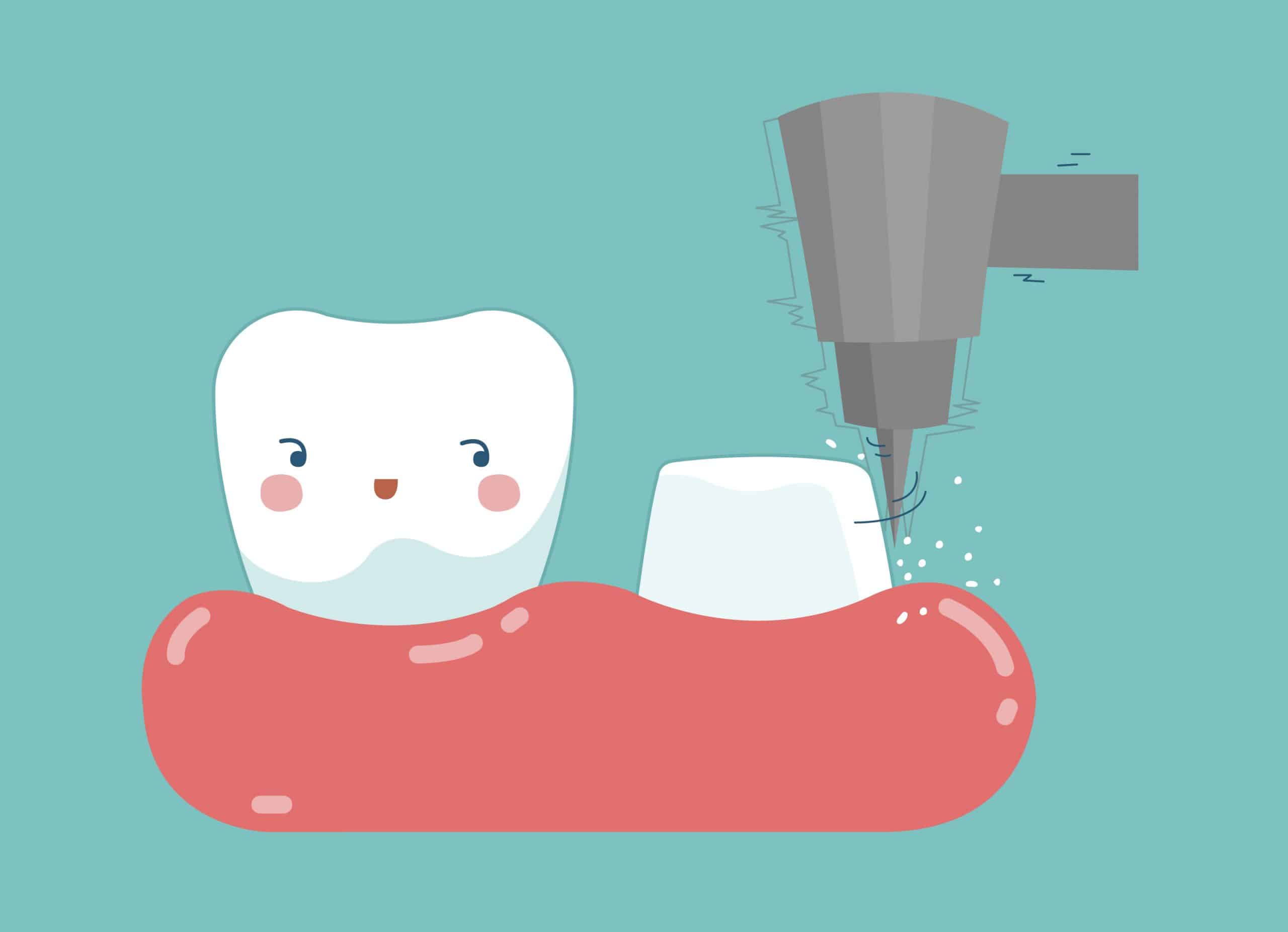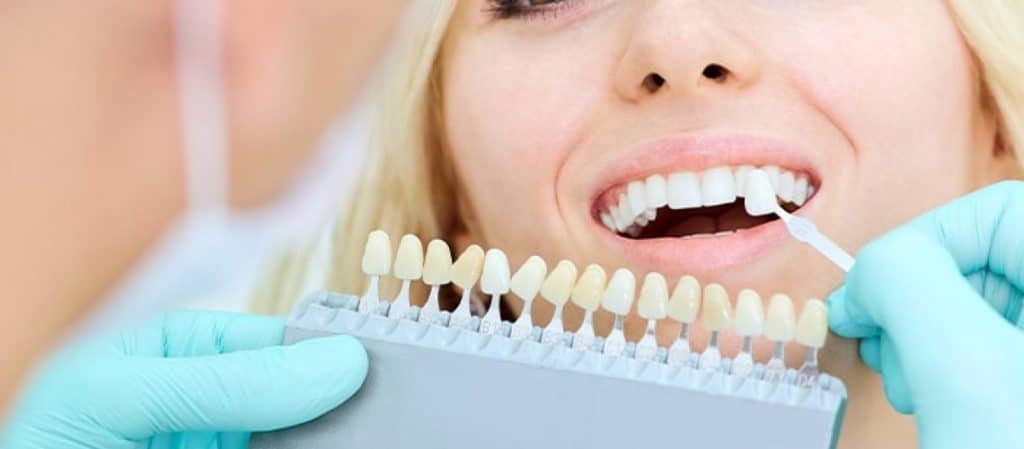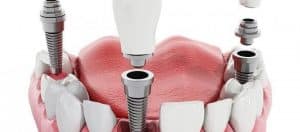What are Dental Crowns?
Dental crowns, also known as caps, are prosthetic restorations that encase a damaged or decayed tooth, restoring its shape, size, strength, and functionality. Whether you’re considering a dental crown or have recently undergone the procedure, understanding the steps involved and how to care for your crown is crucial for maintaining optimal oral health.
Dental crowns are the ideal way to restore your smile. Missing or damaged teeth can create problems in biting and chewing food. Having the problematic tooth or teeth replaced by a crown gives you the liberty to bite and chew on foods easily, thus having a positive impact on the other systems in your body, like your digestive system. A dental crown is a fixed prosthetic device placed over a damaged or missing tooth. The purpose of this tooth-shaped cap is to cover the damaged tooth and restore its look, shape, size, and strength.
Here’s a comprehensive guide to the dental crown procedure and post-procedure care:
Dental Crown Procedure
1. Initial Consultation:
- During the initial consultation, your dentist will assess your oral health, discuss the need for a dental crown, and explain the procedure. X-rays may be taken to evaluate the condition of the affected tooth.
2. Tooth Preparation:
- To make room for the dental crown, the affected tooth is prepared by removing any decayed or damaged portions. In some cases, additional structure may be removed to create a proper fit for the crown.
3. Impression Taking:
- An impression of the prepared tooth is taken to create a mold for the custom fabrication of the dental crown. This mold ensures a precise fit and natural appearance.
4. Temporary Crown Placement:
- While the permanent crown is being fabricated, a temporary crown is placed over the prepared tooth to protect it and maintain functionality. It is essential to avoid chewing sticky or hard foods on the temporary crown.
5. Crown Fabrication:
- The impression is sent to a dental laboratory where skilled technicians craft the permanent crown using materials like porcelain, ceramic, metal, or a combination. The color is matched to your natural teeth for a seamless blend.
6. Crown Fitting:
- Once the permanent crown is ready, you return to the dentist for the fitting. The temporary crown is removed, and the permanent crown is placed and adjusted for proper fit and bite.
7. Cementation:
- Once the fit is confirmed, the permanent crown is cemented into place using dental adhesive. Any adjustments are made to ensure comfort and proper alignment with neighboring teeth.
What Are the Benefits of Dental Crowns?
Dental crowns provide a range of advantages that contribute to oral health and aesthetics. These custom-made caps offer protection and reinforcement to weakened or damaged teeth, preventing further deterioration and the need for extraction.
With durable materials like porcelain and ceramic, dental crowns can withstand daily biting and chewing, restoring full functionality to compromised teeth.
Additionally, crowns are tailored to blend seamlessly with your natural teeth, enhancing your smile’s appearance while addressing issues like discolouration, misshapen teeth, or large fillings.
By preserving tooth structure, supporting dental bridges, and aiding after procedures like root canals, dental crowns offer a comprehensive solution to various dental concerns, resulting in improved oral health, confidence, and overall well-being.
Caring For Your Dental Crowns
Caring for your dental crowns is essential to ensure longevity and maintain oral health. Proper care helps prevent complications, such as decay at the crown margins or gum irritation. Regular oral hygiene practices like brushing, flossing, and routine dental checkups are crucial to keeping the crowned tooth and surrounding teeth healthy. Avoid habits like biting on hard objects or grinding your teeth, as these can potentially damage the crowns. By prioritising their care, you can enjoy the benefits of your dental crowns for years to come.
Dental Crown Cost Melbourne, Australia
The cost of a dental crown can vary widely due to the unique nature of each individual’s dental needs. However, you may expect to pay a price of $ 1,000 to $ 2,000 per dental crown in Melbourne, VIC. Several factors play a role in determining this cost, such as the extent of the tooth damage, the tooth’s location (front or back), whether additional procedures like a root canal are necessary, and the complexity of the overall procedure.
When Would a Dental Crown Be Needed?
There are various situations in which you may require dental crowns. Here are some of them:
If you have managed to break your teeth either partially or completely due to an accidental fall, you can count on a dental crown. Your dentist will suggest that you replace your broken or missing teeth with a dental crown to fill in space or make your smile perfect again.
Large filling
If your tooth has a cavity that is half its width, you know it is time to consult your dentist. There is a high chance your dentist will recommend a dental crown, as filling a large portion of your tooth is difficult. Even if your dentist manages to implant a large filling, there is a high chance of your tooth showing signs of stress and cracks. The dentist will eventually suggest you have a dental crown placed on your damaged tooth.
Root canal
You will require a dental crown if you have undergone a root canal treatment. After a root canal treatment, your tooth may hollow out and predispose the remaining tooth to cracking. It would help if you got a dental crown for the operated tooth to avoid this.
Excessive wear of teeth
If you habitually grind your teeth, you will require a dental crown soon. Grinding your teeth can cause them to shorten over time. Also, there are chances of your teeth wearing out due to acid erosion that may occur due to an acidic diet or bulimia. A worn-out tooth can collapse due to biting; hence, restoring the tooth to its original size is important. To regain its normal size and shape, a dental crown is required.
Unacceptable appearance of teeth
Your tooth may lose its colour or shape due to various reasons. The unacceptable appearance of a tooth, especially in the front, can take away your confidence to smile. In such a case, a dental crown can come to your rescue. You can replace your ‘not-so-good-looking tooth’ with a dental crown that offers a natural look and gives you a perfect smile.
What Types of Dental Crown Materials Are Available?

Crowns can be made of different dental crown materials:
- Stainless steel: Stainless steel crowns are used as a temporary measure on permanent teeth. They are usually used to protect the tooth or filling till the time a permanent crown of another material is ready.
- Metals: Crowns can be made of metals like gold, alloy, and platinum. As metals are known to be sturdy and durable, a crown made of any metal can withstand a lot of pressure. The only drawback of a metal crown is its metallic, unnatural colour.
- Porcelain-fused-to-metal crown: Many times, crowns are made using a mix of porcelain and metal. Porcelain helps to create a crown that matches the colour of your adjacent teeth, whereas metal makes it slightly durable. However, a porcelain-fused-to-metal crown can still wear down easily.
- Resin: Crowns made of resin have the lowest dental crown cost. However, they wear down easily, and you may have to replace them soon. Resin crowns are more susceptible to cracks than any other material crowns.
- All-ceramic or all-porcelain: Crowns made of ceramic and porcelain match the natural colour of the teeth. They are ideal for patients who have metal allergies. A crown made of ceramic is perfect for replacing both front and back teeth.
What Is the Procedure for Getting a Dental Crown?
On the first visit to your dentist, expect them to examine your teeth. Examining the teeth gives your dentist an idea of which procedure to opt for. Two processes can help you get a dental crown: a traditional and quick one-hour process. Regardless of the dentist’s processes, you may be asked to get an X-ray done to examine the site. A few x-rays will be enough for your dentist to analyse if your teeth roots are healthy. If the tooth that requires a crown has decayed to a great extent or has a risk of infection, the dentist will suggest that you undergo a root canal treatment first.
Traditional method
In the case of the traditional method, your tooth will need to be built up once the root canal is done. Your dentist will use a filling to restore the tooth so the crown will hold onto it better. First, you will get a temporary dental crown that will be later replaced with a permanent one. The next step involves getting the impression of your tooth to create the permanent crown. Your dentist will either use putty or a digital scanner for this task. The dental crown moulding or scan will then be sent to the dental lab for creating the permanent crown. You can expect the permanent crown to be made in 2-3 weeks. In the next visit, your dentist will take out the temporary crown and check the fit and colour of the permanent crown. If the permanent crown is perfect, your dentist will cement the new crown in its place.
One-hour method
The alternative to this traditional method is the ‘crown in one-hour method’, which is pretty quick, as its name suggests. With this procedure, you can expect your dentist to fix the crown in just one appointment. This is possible with the help of computer-aided design and computer-aided manufacturing technologies. The computer-aided design makes it easy for the dentist to design the custom crown for you, depending on the impression taken. On the other hand, computer-aided manufacturing technology allows for quickly creating a custom design. The steps involved in this procedure are almost the same as the traditional method. The only difference is that the dentist uses computer software to make the crown in less than an hour.
How To Take Care of Your Dental Crown?
You must maintain a good oral hygiene routine to take care of your dental crown. Here are some tips for you to follow:
- Brush your teeth two times a day.
- Use a sensitivity toothpaste if needed.
- Avoid sticky or chewy foods, as they can loosen the dental crown.
- Avoid eating from the side on which you have recently got a crown fixed.
- Properly floss out the food particles from around the crown area.
- Don’t use your crown to do the job of a scissor..
- Do not grind your teeth to prevent your crown from wearing out soon.
- Get rid of bad habits like chewing your nails or chewing ice.
- Visit your dentist regularly for professional cleanups.
What Problems Could Develop with A Dental Crown?
If you do not take proper care of your crown, there are chances of experiencing some dental problems.
Dental decay
If you do not clean your teeth thoroughly, plaque can accumulate at the point where the crown and the tooth meet. Though the collected plaque cannot decay the crown, it can decay the tooth. Hence, brushing and flossing your teeth twice a day is necessary.
Loose crown
Eating chewy food items can cause your crown to loosen up. In such a scenario, it is important to visit your dentist immediately. A loose crown can allow the bacteria to enter inside and further decay or damage the tooth.
Nerve issues
Setting a crown for a tooth can irritate the nerves resting in the tooth’s soft pulp. Affected nerves can lead to slight or extreme pain. You may notice the symptoms of nerve issues months after the fixing of the crown. In this case, it is best to consult your dentist to get a root canal and replace the crown.
A dark line at the gum
This problem is common with porcelain-infused-with-metal crowns. There are chances of the metal of the crown showing, which is why you can see a dark line. Though this is harmless, it is not aesthetically pleasing.
Frequently Asked Questions (FAQs) about Dental Crown Procedure and Care
Why might I need a dental crown?
Dental crowns are recommended to restore teeth that are severely decayed, damaged, weakened, or have undergone root canal therapy. They can also be used for cosmetic purposes.
How long does the dental crown procedure take?
The dental crown procedure typically involves two appointments. The first appointment includes tooth preparation and impression-taking, while the second appointment involves crown fitting and cementation. Each appointment may take about an hour.
Is the dental crown procedure painful?
The tooth preparation phase may involve local anesthesia to ensure comfort. Patients may experience some sensitivity or discomfort after the anesthesia wears off, but this is usually temporary.
How long do dental crowns last?
The lifespan of a dental crown depends on factors such as oral hygiene practices, diet, and the material used. On average, dental crowns can last between 5 and 15 years or more with proper care.
What materials are used for dental crowns?
Dental crowns can be made from various materials, including porcelain, ceramic, metal (such as gold or alloy), or a combination of materials. The choice depends on factors like aesthetics, durability, and the location of the tooth.
Can dental crowns be whitened?
Porcelain and ceramic dental crowns are resistant to staining, but they cannot be whitened like natural teeth. If you are considering teeth whitening, it’s advisable to do it before getting a dental crown.
Can dental crowns fall off?
While rare, dental crowns can become loose or fall off. This can happen due to issues with the cementation or underlying tooth structure. If this occurs, contact your dentist for prompt evaluation and re-cementation.
Can I eat normally with a dental crown?
Yes, dental crowns are designed to withstand normal biting and chewing forces. However, it’s advisable to avoid biting on hard objects or extremely sticky foods to prevent potential damage.
How do I care for my dental crown?
Maintain regular oral hygiene practices, including brushing and flossing. Avoid chewing on hard foods, and wear a night guard if you grind your teeth. Attend regular dental check-ups for monitoring and professional cleanings.
Can dental crowns be replaced?
Over time, dental crowns may need replacement due to wear, damage, or changes in oral health. Your dentist will assess the condition of your crown during regular check-ups and recommend replacement if necessary.
Does dental insurance cover the cost of dental crowns?
Dental insurance coverage for dental crowns varies. It’s advisable to check with your insurance provider to understand the extent of coverage and any out-of-pocket expenses.
Can I get a dental crown in one day?
We offer same-day crown procedures using technologies like CEREC. However, traditional crown procedures usually involve two appointments for tooth preparation and crown placement.
Is there any discomfort after getting a dental crown?
It’s common to experience some sensitivity or discomfort after the anesthesia wears off. This is usually temporary, and over-the-counter pain relievers can help alleviate any discomfort.
How Often Should I Visit the Dentist for A Checkup After Crown Placement?
After you get a crown, it’s important to see your dentist again in 2 to 4 weeks to examine the fit of your crown. Your dentist might make small changes if needed. After this, it is recommended to visit the dentist every six months for regular checkups. These sessions will ensure that the crown stays in good shape and help find any possible oral health issues early so you can prevent big dental problems later.
Can Dental Crowns Get Cavities?
While some believe dental crowns are immune to cavities, this isn’t accurate. If a crown doesn’t fit well, spaces between it and the tooth can allow food and bacteria in, leading to decay and cavities. Proper oral hygiene matters, too, as plaque buildup around the crown can cause bacterial decay, resulting in cavities. Regular dental care and a well-fitting crown are key to preventing this.
How Long Does It Take to Feel Better After a Dental Crown Procedure?
After a dental crown procedure, individuals typically find that they can return to their regular activities, such as work and school, right away. However, it’s common to experience sensitivity, especially to hot and cold temperatures, for a few weeks. It’s also normal to feel soreness or tenderness in the gums surrounding the treated tooth. Fortunately, these side effects are temporary and resolve within some days. Over-the-counter pain relievers can help manage any discomfort during this recovery period.
What Types of Food Should I Eat After Crown Placement?
After crown placement, it’s advisable to stick to soft foods that don’t exert excessive pressure on the treated area. Opt for mashed potatoes, yogurt, soups, pasta, and smoothies. Avoid hard, crunchy, or sticky foods initially not disturb the healing process and prevent any discomfort or damage to the new crown.
Contact Us
Visit Bay Dental Group website for more information on dental crowns. You can call us on (03) 9923 7633 to book an appointment or inquire about the dental crown price in Melbourne.












